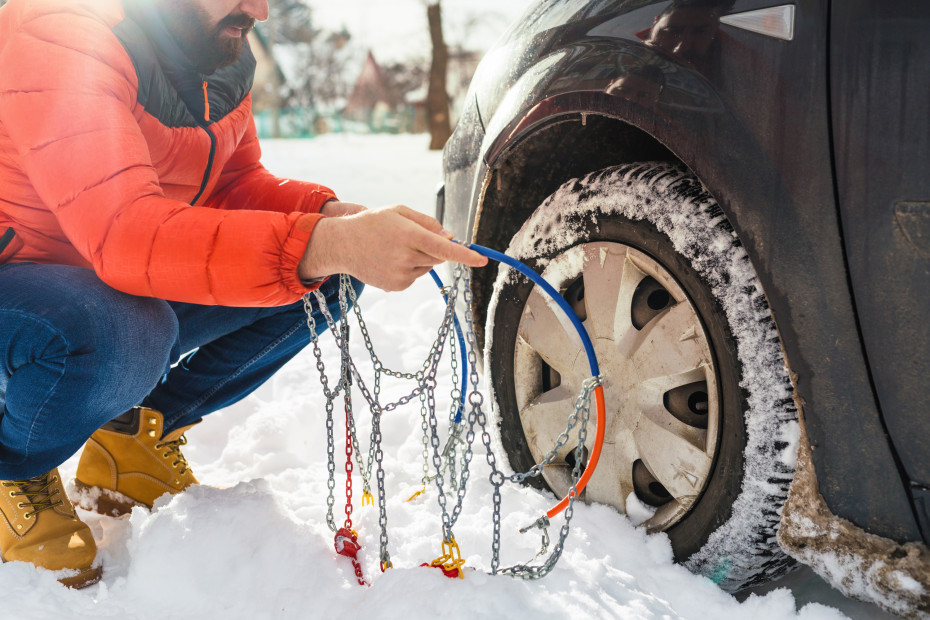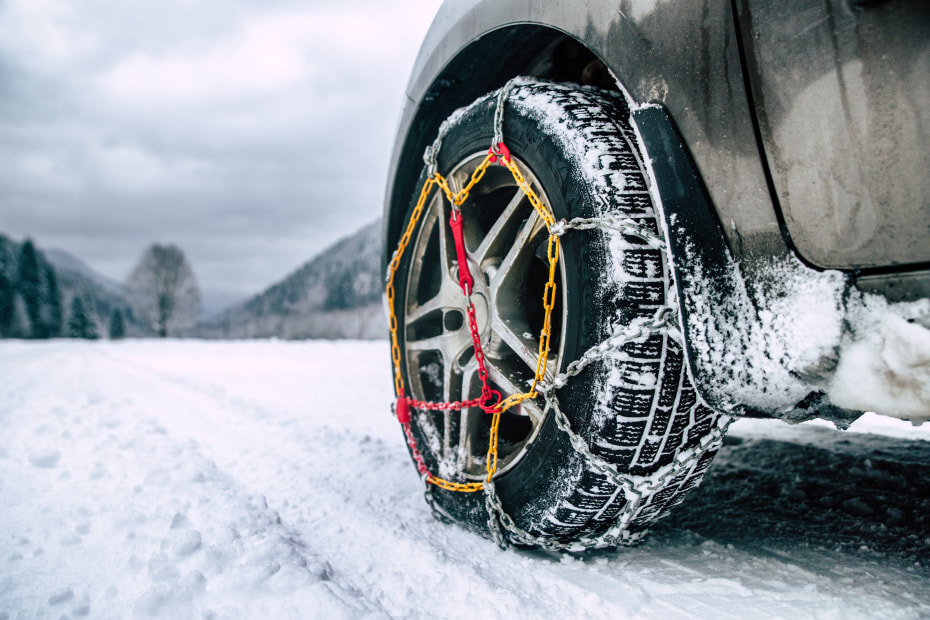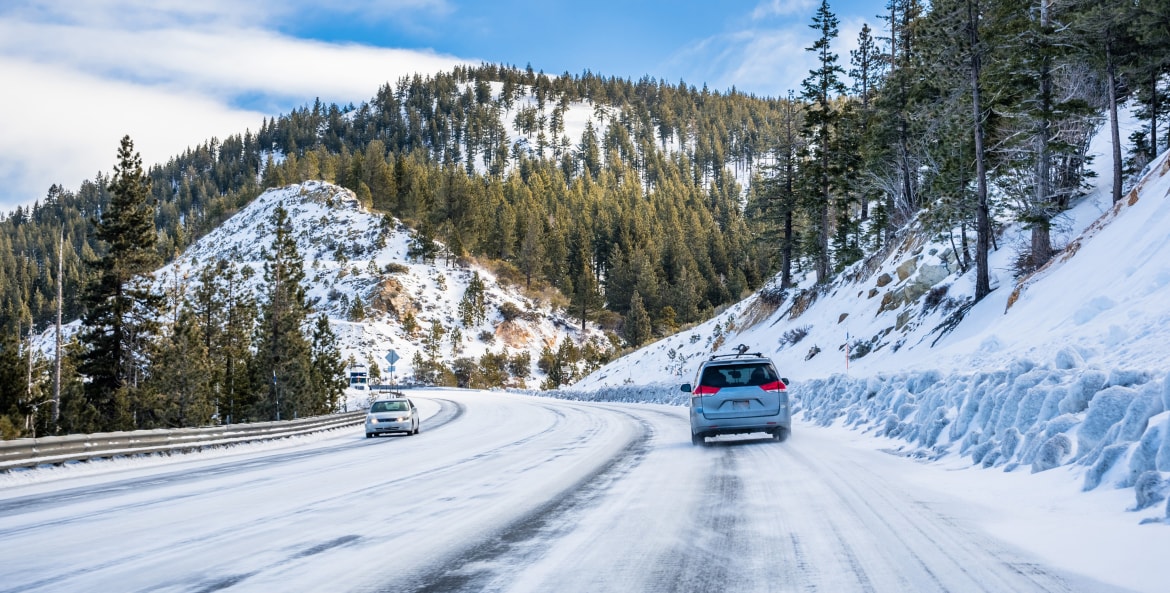Driving in the snow can be challenging and stressful, but practice, proper gear, and advanced preparation can increase your safety and comfort. With the right traction devices on hand, and knowing both when you need them and how to install them, driving on winter roads will feel a lot less daunting.
The Differences Between Snow Tires, Cables, Chains, and Socks
Snow or winter tires are specifically designed for better traction and performance in freezing temperatures and on snow and ice than all-season tires. While some all-season tires may have “M+S” stamped on the sidewall to show they have deeper treads for mud and snow, a true winter tire will also have a mountain symbol with a snowflake inside. In many cases, snow tires are sufficient for driving on snow-covered roads and will not require additional traction devices, such as chains or cables. Winter tires are ideal for drivers who need to navigate freezing temperatures and snow all season long.
Cables work much like chains in that they wrap around your tires and help your vehicle grip the road when conditions make it difficult for standard tires to maintain traction. Cables are lighter and can be easier to install than chains. They are less likely to damage your vehicle if they break, a rare but not impossible scenario. While they won’t last as long as a set of chains, cables are a good choice if you don’t need them very often.
Chains are a tougher product all around, but they can be harder to install and heavier. However, if you need to frequently drive in the snow or you want a product that will last longer, they can be an excellent choice.
Tire socks are a newer traction solution where a fabric sleeve wraps around the tire and is secured with elastic bands. They’re easy to install and can help if your wheels are spinning, but they’re not universally approved for use where chains are required. If you have socks, check with the department of transportation along your route to make sure they’re acceptable when chains are required.

Find a safe place away from traffic to install tire chains.
How to Install Chains and Cables
Once you have your chains or cables, read through the instructions and install them at home or another safe place so you know how they work. You’ll be more prepared—and spend less time in the cold—when conditions arise that require chains if you’ve already practiced getting them on and off.
Chains and cables go on your “drive” wheels, so if your vehicle is front-wheel drive, you will put chains on both of your front tires. Check your car’s manual if you are unsure which are your drive wheels. Using four wheel drive? You need chains for all four tires when 4WD is engaged and conditions require chains for 4WD vehicles.
While every chain or cable will be installed similarly—you will wrap the traction device around the wheel and tighten the fasteners to ensure a snug fit—always follow the instructions included with your chosen device to get a safe and secure fit.
Smart Tip: Put the instructions in a waterproof sleeve or bag and store them with your chains so you can easily read them in wet conditions on the side of the road.
Every fall, give yourself a refresher course on how to install your chains or cables, and check your gear over for wear and tear to see if it needs updating. Don’t assume your old chains will work on a new vehicle, either. Double check well before you hit the road that they actually fit.
When to Use Chains or Cables
The local department of transportation will tell you when chains are required; check websites for current road conditions in mountain passes and other areas before you hit the road. But chains or cables are helpful anywhere there’s compacted snow or ice covering the roads—covering being the key attribute here. A patch of snow here and there isn’t cause to break out the chains; extensive coverage is.
When highway signs indicate tire chains are required, you will usually have about a mile to stop and install your chains or cables. Often there’s a designated area to do so. But control areas can shift rapidly from place to place because of changing weather and road conditions. Your safety is paramount; stop and install your chains as soon as it’s safe to do so.
Don’t rush the process. Install your chains or cables, roll the car forward a length or two and tighten them. Drive a half mile or so and stop once more to make sure the chains or cables are secure, tightening them again if needed. Then you can hit the road.

Drive slowly and mindfully when using tire chains.
How to Safely Drive with Chains and Cables
Once your chains or cables are securely installed, drive slowly: 20 to 30 miles an hour is typically the maximum speed, but follow posted signs in chain control areas and be prepared for slower traffic ahead. You may have to drive short distances on bare pavement, but if the road is clear, stop the vehicle as soon as it’s safe to do so and take the chains off. Follow any posted instructions and keep your radio tuned to a local station for up-to-date information—conditions can change rapidly.
If you hear any banging or slapping noises, stop immediately to ensure your chains are sufficiently tight and that nothing is broken. A broken snow chain can cause significant damage to your vehicle. If your chain or cable breaks, treat it as an emergency. Pull off the road as soon as it’s safe and contact roadside assistance.
As in all winter driving conditions, leave additional space between the car in front of you and avoid sudden moves, such as slamming on the brakes, turning hard on the wheel, or accelerating quickly. Slick surfaces combined with abrupt movements can cause you to lose traction and control. Slow, steady, and intentional is your best approach for winter driving, with or without chains.
When to Remove Your Chains
Don’t drive with chains on bare pavement; as soon as you see signs saying “End Chain Control” and you are on plowed and/or salted roads, pull over when safe to do so and remove them. Find a parking lot or roadside turnout with plenty of space and visibility to remove your chains.
Done for the winter? Make sure your chains are clean and dry before you pack them away for the year. Spray your chains with a water based lubricant like WD-40 before you put them away. If you’ve got the space to do so, hang them up in a dry garage, basement, or workshop. That way, they’ll be easy to inspect in advance of next season’s snow driving.
